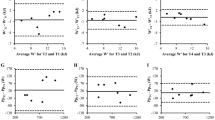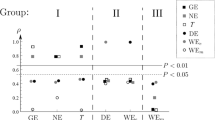Conclusions
The following conclusions are justified from the data presented in this investigation.
-
1.
In order to obtain a pulse-ratio of 2.5 a trained subject requires eight trials of exercise 1, nine trials of exercise 2, eight trials of exercise 3, nine trials of exercise 4, and seven trials of exercise 5.
-
2.
A survey of men in physical education classes, who receive the regular class instruction, shows that the group is heterogeneous, containing good, medium and poor performers on the parallel bars. For the most part these students are far inferior to those who specialize in this activity, although a few are equally as good.
-
3.
The pulse-ratio test definitely points out differences in efficiency in performing on the parallel bars. It is reliable for picking out those who are proficient as well as indicating those who are inefficient.
Similar content being viewed by others
Bibliography
Hambly, W. D., M. S. Pembrey andE. C. Warner, The Physical Fitness of Men Assessed by Various Methods. Guy's Hosp. Rep.75, 388–394 (1925).
Hambly, W. D., G. H. Hunt, L. E. L. Parker, M. S. Pembrey andE. C. Warner, Tests for Physical Efficiency. Guy's Hosp. Rep. Part 2,72, 367–385 (1922).
Hunt, G. H. andW. S. Pembrey, Tests for Physical Efficiency. Guy's Hosp. Rep. Part 2,71, 415–428 (1921).
Tuttle, W. W. andJ. S. Skein, The Efficiency Rating of High School Boys as Shown by the Pulse-ratio Test. Research Qr.1, 19–33 (1930).
Tuttle, W. W. andHenryetta Frey, A Study of the Physical Efficiency of College Women as Shown by the Pulse-ratio Teat. Research Qr.1, 17–25 (1930).
Tuttle, W. W. andR. C. Wilkins, The Application of the Pulse-ratio Test to Effficiency in Performing on Gymnasium Apparatus. The Horizontal Bar. Arb.physiol.3, 449–455 (1930).
Tuttle, W. W., The Use of the Pulse-ratio Test for Rating Physical Efficiency. Research Qr.1931 (In press).
Tuttle, W. W. andGeo. Wells, The Response of the Normal Heart to Exercises of Graded Intensity. Amer. J. Physiol. (In press)1931.
Author information
Authors and Affiliations
Rights and permissions
About this article
Cite this article
Schroeder, E.G., Tuttle, W.W. The application of the pulse-ratio test to efficiency in performing on gymnasium apparatus. Arbeitsphysiologie 4, 443–452 (1931). https://doi.org/10.1007/BF02010112
Received:
Issue Date:
DOI: https://doi.org/10.1007/BF02010112




